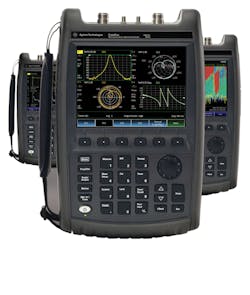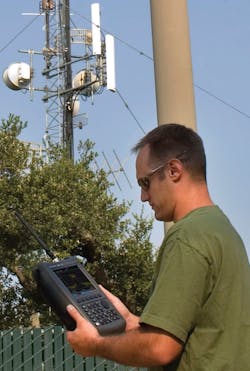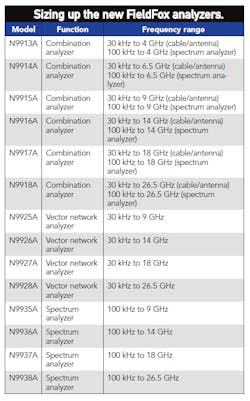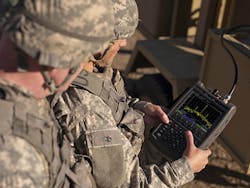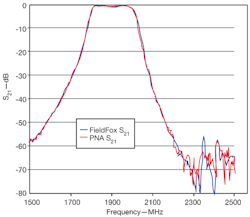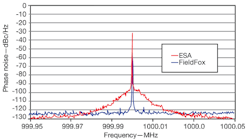Microwave measurements are increasingly performed in the field, especially as RF/microwave communications infrastructure continues to expand. Unfortunately, in-field measurements have long been associated with portable test equipment of questionable performance and quality, at least when compared with laboratory-grade RF/microwave test instruments. However, the latest additions to the FieldFox family of portable analyzers from Agilent Technologies may change more than a few opinions on portable RF/microwave test equipment; the 14 new members of the portable test line include spectrum analyzers, cable/antenna analyzers, and vector network analyzers operating to 26.5 GHz, with lab-worthy accuracy and precision.
The new FieldFox portable analyzers (Fig. 1) are configured for flexibility. A user can start simply (with a cable and antenna analyzer) and later upgrade with additional measurement functions, such as a spectrum analyzer and/or a microwave vector network analyzer (VNA). The cable and antenna analyzer performs the types of measurements that are most useful to troubleshooters in wired communications systems as well as wireless antenna sites (Fig. 2), including distance-to-fault, return-loss, and cable-loss measurements.
2. The light weight and small size of the FieldFox analyzers makes it a simple matter to bring laboratory-grade measurement power to wired and wireless communications antenna sites.
As the table shows, the FieldFox analyzers offer a wide range of frequency models through 26.5 GHz. In addition, they are built for the field, housed in sealed enclosures that are compliant with US MIL-PRF-28800F Class 2 requirements, to withstand the rigors of in-field testing. The instruments and their housings are type tested to meet MIL-STD-810G, Method 511.5 Procedure 1 requirements for operation in explosive environments. The housings are without vents or fans, and designed to handle high levels of shock and vibration. A custom-designed connector bay protects its connectors from damage due to drops or mishandling.
FieldFox analyzers are available in one of three base configurations: as a cable and antenna analyzer, as an RF/microwave VNA, or as a microwave spectrum analyzer. The cable and antenna analyzer can be expanded by means of optional add-on instrument functions, such as a spectrum analyzer, a VNA, a vector voltmeter, DC source, or a power meter. They can also be upgraded with any of these options at a later date through a simple license key process without the need to send the instrument to a service center. The base configuration with the RF/microwave VNA can be expanded with options for performing full two-port S-parameter measurements, time-domain analysis, a cable and antenna analyzer, a vector voltmeter, and a power meter. Finally, the base configuration with spectrum analyzer can be expanded with options for a full-band tracking generator, a full-band preamplifier, an interference analyzer and spectrogram, reflection-measurement capability, a power meter, and even a frequency counter.
3. The small size of the FieldFox analyzers makes them easy to manage in rugged terrain and difficult environments, whether in commercial, industrial, or military measurement applications.
The FieldFox instruments (Fig. 3) are only 7.4 in. (188 mm) wide and easy to hold, boasting an easy-to-navigate control panel with large keys that can be controlled in the field, even when wearing gloves (Fig. 4). Data are shown on a 6.5-in. thin-film-transistor (TFT) display. The low-reflectivity screen provides clear viewing during the day, while backlit control keys help when working in darkness. The light-weight (6.6 lbs or 3.0 kg) analyzers run on rechargeable lithium-ion batteries. They draw about 14 W power during normal operation and run for about 3.5 h on a battery charge. They maintain their rated measurement accuracies over operating temperatures from -10 to +55°C.
4. The large keys used in the FieldFox analyzer front panel can be controlled even when wearing gloves.
These portable testers may be light in weight, but they provide substantial measurement power, drawing from some of the firm’s leading benchtop test instruments. For example, the RF/microwave VNAs in the FieldFox analyzers compare favorably with the PNA series of benchtop VNAs. In measurements of S21 forward transmission on a bandpass filter centered at 1.9 GHz, a side-by-side comparison of a FieldFox analyzer with a PNA reveals very little difference (Fig. 5). The FieldFox VNAs are quite capable, relying on built-in calibration hardware and highly accurate calibration algorithms for precise, repeatable measurements. They use built-in calibration standards, enabling VNA measurements in the field without additional accessories.
5. This comparison of the S21 forward transmission response of a bandpass filter shows the performance similarities of a FieldFox analyzer versus a benchtop PNA vector network analyzer.
The VNAs are full two-port instruments with four receivers, capable of measuring the phase and magnitude of all four S-parameters with a dynamic range to 100 dB at lower frequencies and 94 dB to 18 GHz. The FieldFox VNAs feature low trace noise of ±0.004 dB. They can also simultaneously display all four S-parameters, and perform gated time-domain analysis. A guided calibration wizard simplifies any calibration steps that need be taken prior to VNA measurements with a FieldFox analyzer.
In addition, the VNAs feature several automatic calibration functions. For example, QuickCal is a built-in function that provides a means of performing a fast two-port calibration without a calibration kit of physical standards. It automatically corrects for phase shifts and loss of cables and adapters and electrically shifts thecalibration plane of the VNA to the end of these interconnect components, and to the ports of the device under test (DUT). With the CalReady function, the FieldFox’s VNA is automatically calibrated to the instrument ports when power is turned on.
The FieldFox spectrum analyzers draw from Agilent’s PSA line of microwave spectrum analyzers (Fig. 6). The spectrum analyzers provide amplitude accuracy of ±0.5 dB with no warmup time required, and offer a typical spurious-free dynamic range (SFDR) of 105 dB. The spectrum analyzers benefit from InstAlign, an automatic amplitude alignment that contributes to maintaining the ±0.5-dB amplitude measurement accuracy. The spectrum analyzers in the FieldFox portable instruments also leverage Agilent’s PowerSuite one-button measurement functions from the firm’s benchtop instruments. These functions allow users to make quick power measurements of communications channels by pressing a single button. For their part, the FieldFox cable and antenna analyzers provide precision measurements with ±0.5 dB amplitude accuracy.
6. These two phase-noise plots show the outstanding performance of the FieldFox spectrum analyzer compared to an ESA benchtop spectrum analyzer at 1 GHz.
Looking closer at the performance for a combination analyzer with VNA and antenna and cable analyzer, such as a 26.5-GHz model N9928A, the portable instrument is equipped with a built-in frequency reference boasting typical accuracy of ±0.4 ppm from -10 to +55°C. That reference accuracy can be improved to ±0.010 ppm when the analyzer is locked to a Global Positioning System (GPS). The built-in frequency reference has an aging rate of ±1 ppm/year for 20 years. The measurement frequency resolution of the N9928A analyzer is 1 Hz to 5 GHz, 1.34 Hz to 10 GHz, 2.68 Hz to 20 GHz, and 5.36 Hz to 26.5 GHz. The VNA provides typical test port power of -1 dBm from 3.0 to 6.5 GHz, -2 dBm from 6.5 to 9.0 GHz, -4 dBm from 9 to 14 GHz, -6 dBm from 14 to 18 GHz, -10 dBm from 18 to 23 GHz, and -12 dBm from 23 to 26.5 GHz. Power can be set in 1-dB steps. The power level accuracy is typically ±1.5 dB. For the 26.5-GHz VNA is the model N9928A FieldFox analyzer, the typical dynamic range is 100 dB to 9 GHz, 97 dB to 14 GHz, 94 dB to 18 GHz, 90 dB to 20 GHz, 79 dB to 25 GHz, and 70 dB to 26.5 GHz.
The FieldFox analyzers can be equipped with a built-in power meter, which is designed to make absolute power measurements when using one of the firm’s U2000 Series Universal Serial Bus (USB) average power sensors. All of the FieldFox analyzers include local-area-network (LAN) and USB ports for transferring data, as well as a Secure Digital (SD) data card slot for data storage. A three-year warranty is standard for all FieldFox analyzers. Prices start at about $10,200 for the base 4-GHz cable and antenna analyzer model through about $45,000 for a fully equipped FieldFox.
Agilent Technologies, Inc., 5301 Stevens Creek Blvd., Santa Clara, CA 95051; (877) 424-4536, (408) 345-8886, FAX: (408) 345-8475, e-mail: [email protected], www.agilent.com.
